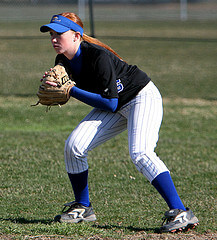There is a lot more to outfield than a lot of people think. When kids are younger, they tend to feel like outfield isn’t fun because they might not get many balls.
I became an outfielder in college, and I’ve learned that being the last line of defense, making a diving catch or robbing a hitter of a home run can be very rewarding.

I’m going to talk about different aspects of outfield play that can help you become a better outfielder. Use these tips and you will see that playing outfield can be fun and that there is always something to work on.
First of all, an outfielder needs to work on the fundamentals and mechanics of outfield play, just like a pitcher, catcher or infielder works on the basics. You need to work on fielding ground balls while keeping your feet moving toward your target because most throws in the outfield are long throws. You also need to work on catching fly balls above the shoulder on the throwing hand side. Catching the ball here and keeping your feet moving toward your target will help you to be quicker and have a stronger throw.
As an outfielder, you have to cover more area to make sure balls don’t get by you. Taking the right angle to approach a ball hit in the outfield will help you to keep the ball in front of you. You always want to get behind the ball hit to your side. You can charge straight to the balls that are hit softer, but your angle to a harder hit ball in the gap will be different. Your first step needs to be back, not sideways. By taking an angle back and to the side, you will be able to cut that ball off. You can work on this by putting a cone out that you have to drop back towards in order to get around it. Remember, it’s the little things that make a big difference!
Our role in the outfield is to be the last line of defense. The pitcher has people behind her, the infielders have outfielders to back them up, but we’re on our own as outfielders. That’s why it is so important to be able to judge balls hit off the bat and to get good jumps. As an outfielder, your first step is always going to be back. It’s a lot easier to run in for a ball after stepping back than it is if you take a couple of steps in and the ball goes over your head.
Remember, your goal is to always keep the ball in front of you. You want to react as soon as the bat makes contact with the ball. The more practice you have in the outfield, the quicker you will react. You will also need to be able to judge where the ball is so you know how far in or far back you have to run. Here is the tip: If the ball is hit and the ball is above the bat, your first step is going to be back. If the ball comes off at a downward angle, you can run in because you know it’s going to be a ground ball. Anticipation is the difference between a good outfielder and a great outfielder. You have to be ready every pitch and you have to assume the ball is going to be hit to you.
So far we’ve covered a few basic mechanics and gone over reacting to the ball. Next we are going to talk about communication and knowing your position. Communication is very important in the outfield. You need to talk to your infielders to let them know if you’re deep or shallow in the outfield. That gives them an idea of how far back they need to run for a ball over their heads.
You also need to communicate with your other outfielders. Besides talking about where you’re playing on different batters, there always needs to be talk when the ball is hit in the outfield. If you know you can catch a fly ball, you always need to call for it by saying “mine” or “I got it”. The more communication there is, the less likely for a collision or for letting a ball drop. Communication becomes easier when you know the abilities of the person playing next to you. There is always somewhere for you to be in the outfield, even if the ball doesn’t come to you. Backing up throws is very important, so you need to make sure you’re always in the right place. Remember, you are the last line of defense, so you need to be that much more ready.
As you can see, there is a lot more to outfield than just standing behind the infielders and getting a few fly balls. We talked about mechanics, reaction, communication and know your position, but there is still a lot of other situations that we didn’t have time for. You need to know where to throw the ball in different situations, especially cut-offs, and how to play balls in the sun or off the fence.
It takes a lot of little things to become a great outfielder. Most importantly, you need to want to be out there and have fun with it. These little things will lead to saving a game by making a diving catch. Good luck in the outfield and remember: “NOTHING DROPS IN!”